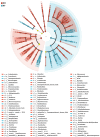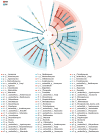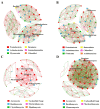Response of the Endophytic Microbiome in Cotinus coggygria Roots to Verticillium Wilt Infection
- PMID: 39590711
- PMCID: PMC11595824
- DOI: 10.3390/jof10110792
Response of the Endophytic Microbiome in Cotinus coggygria Roots to Verticillium Wilt Infection
Abstract
Verticillium wilt caused by Verticillium dahliae Kleb. is a lethal soil-borne fungal disease of Cotinus coggygria. The plant endophytic microbiome plays an important role in maintaining plant health and disease resistance, but it is unclear how the endophytic microbiome of C. coggygria roots varies in response to Verticillium wilt occurrence. In this study, the endophytic microbial diversity, community composition, dominant species, and co-occurrence network of C. coggygria under Verticillium wilt-affected and healthy conditions were assessed using Illumina sequencing. Compared with healthy plants, the bacterial alpha diversity indices of Verticillium wilt-affected plants decreased significantly, while the fungal alpha diversity indices showed obvious increases. The relative abundance of dominant taxa including Proteobacteria, Actinobacteriota, Ascomycota, and Basidiomycota at the phylum level, as well as Gammaproteobacteria, Thermoleophilia, Dothideomycetes, and Agaricomycetes at the class level, differed significantly between Verticillium wilt-affected and healthy plants. Co-occurrence networks revealed that the fungal network of Verticillium wilt-affected roots was denser with more negative interactions, which may be relevant to functional changes from reciprocity to competition in the microbial community, in response to V. dahliae infection. The results enhanced our understanding on the relationships between the endophytic microbiome and Verticillium wilt, which could provide information for the management of this disease in C. coggygria.
Keywords: Cotinus coggygria; Verticillium dahliae; community composition; endophytic microbiome; illumina sequencing.
Conflict of interest statement
The authors declare no conflicts of interest.
Figures






Similar articles
-
Rhizosphere-associated soil microbiome variability in Verticillium wilt-affected Cotinus coggygria.Front Microbiol. 2024 Jan 5;14:1279096. doi: 10.3389/fmicb.2023.1279096. eCollection 2023. Front Microbiol. 2024. PMID: 38249458 Free PMC article.
-
Rhizobacterial Bacillus enrichment in soil enhances smoke tree resistance to Verticillium wilt.Plant Cell Environ. 2024 Nov;47(11):4086-4100. doi: 10.1111/pce.15004. Epub 2024 Jun 19. Plant Cell Environ. 2024. PMID: 38894696
-
Quantitative Detection of Pathogen DNA of Verticillium Wilt on Smoke Tree Cotinus coggygria.Plant Dis. 2013 Dec;97(12):1645-1651. doi: 10.1094/PDIS-04-13-0406-RE. Plant Dis. 2013. PMID: 30716826
-
The secretome of Verticillium dahliae in collusion with plant defence responses modulates Verticillium wilt symptoms.Biol Rev Camb Philos Soc. 2022 Oct;97(5):1810-1822. doi: 10.1111/brv.12863. Epub 2022 Apr 27. Biol Rev Camb Philos Soc. 2022. PMID: 35478378 Free PMC article. Review.
-
Interactions between Verticillium dahliae and cotton: pathogenic mechanism and cotton resistance mechanism to Verticillium wilt.Front Plant Sci. 2023 Apr 21;14:1174281. doi: 10.3389/fpls.2023.1174281. eCollection 2023. Front Plant Sci. 2023. PMID: 37152175 Free PMC article. Review.
References
-
- Ciocan A.G., Tecuceanu V., Enache-Preoteasa C., Mitoi E.M., Helepciuc F.E., Dimov T.V., Simon-Gruita A., Cogălniceanu G.C. Phenological and environmental factors’ impact on secondary metabolites in medicinal plant Cotinus coggygria scop. Plants. 2023;12:1762. doi: 10.3390/plants12091762. - DOI - PMC - PubMed
-
- Lei Z.P. Study of Verticillium causing Cotinus coggygria wilt in the Beijing area. J. Beijing For. Univ. 1993;15:88–93.
-
- Tang C., Jin X., Klosterman S.J., Wang Y. Convergent and distinctive functions of transcription factors VdYap1, VdAtf1, and VdSkn7 in the regulation of nitrosative stress resistance, microsclerotia formation, and virulence in Verticillium dahliae. Mol. Plant Pathol. 2020;21:1451–1466. doi: 10.1111/mpp.12988. - DOI - PMC - PubMed
Grants and funding
LinkOut - more resources
Full Text Sources

